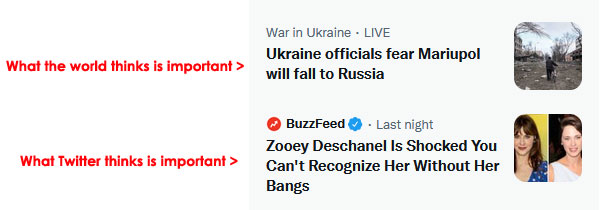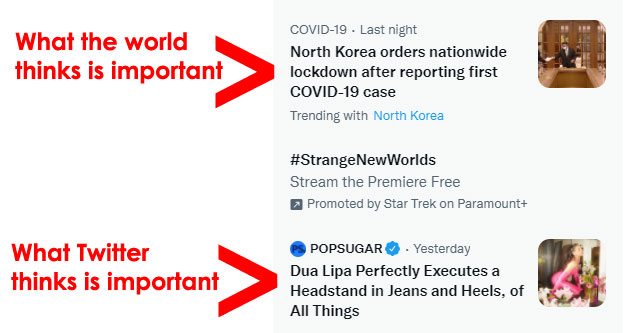Regardless of the eventual outcome of the Twitter-Elon Musk saga, the Tesla and SpaceX mogul’s efforts have elevated one point that millions of users and thousands of shareholders agree on: Twitter has tremendous untapped potential.
On July 22, CNBC reported that, “Twitter reported earnings for the second quarter (of 2022) that missed analyst estimates on earnings, revenue and user growth.” Twitter Blue, the company’s fee-based premium user offering, is of questionable value. User growth is slowing.
Leadership continues to make dubious decisions, from ill-advised account suspensions, to raising the price of Twitter Blue without expanding its features, to being opaque regarding bot accounts on the platform (which caused Musk to balk on his acquisition offer).
Yet Twitter remains a popular and effective platform, particularly for journalists, entertainers, and brands, along with the readers, fans, and consumers who follow them. It’s also, arguably, still the second-best social media platform for B2B marketers, for several solid reasons.
For Twitter to realize the potential that Musk and the social network’s fans believe it has, and avoid falling into a social media death spiral, the platform must continue to grow its user base, as well as the engagement level of its users. Here are five changes that could dramatically improve Twitter’s fortunes and results, regardless of how things end up with Elon Musk.
Verify All Accounts
Requiring all users to verify that they are real human beings or organizations, and identifying themselves as such, could initially cause Twitter’s DAU and MAU numbers to drop. That’s a serious risk, but one outweighed by the potential rewards.
Part of the appeal of LinkedIn is that it’s very difficult to set up or grow fake accounts there. On Twitter, there are too many accounts with names like @lisa982645 that may be real people—or may be experiments by junior coders, or Russian bots, or anonymous trolls.
While verifying accounts might reduce DAU/MAU numbers in the short term, it would increase the value of the accounts that remain, and improve the user experience. It would eliminate (to the extent possible) bots and fake accounts as well as the noxious, imbecilic hate speech so often spread through anonymous tweets.
Clarify the Blue Check Process
Earning a blue check is a coveted mark of recognition on Twitter. But the process remains opaque, arbitrary, and just plain broken. As Kaivan Shroff (a political commentator with 113,000 followers) points out on WBUR, “Because Twitter is an increasingly central platform for the dissemination of political and social information, its flawed policies have consequences at scale.”
To raise just a couple of example, Sharlyn Lauby and Meghan Biro are both brilliant, influential leaders in the human resources space. Sharlyn, with 34,823 followers, has a well-deserved blue check. But somehow Meghan, with nearly fours times the following (137,176) doesn’t.
Or consider Ryan Biddulph and Anthony Gaenzle. Both write about marketing generally, and blogging more specifically. There’s a lot of crossover among their audiences. Ryan, with more 47,000 followers, doesn’t have a blue check. Anthony (to his credit!), with one-fifth the following, does.
Of course, Twitter can establish whatever criteria it likes for awarding blue checks. But the process should be clear, fair, and consistent.
Fix the Sidebar
How often have you seen the highly visible and incredibly valuable screen real estate of Twitter’s sidebar wasted in ways like this?
There is so much potential here to show users what is important to them, as individuals. Maybe it’s stock updates, world news, industry-specific updates, tweets relating to a specific hobby or interest, whatever.
But enabling users customize this space to show information they think is important. Not what matters to the clique of junior-high girls who apparently control the sidebar currently.
Ramp Up Marketing
When was the last time you saw any creative, compelling marketing done by Twitter? When was the last time you saw any marketing from the platform?
Granted, Twitter does send out occasional email messages to prospective advertisers. The time and effort would be arguably better spent trying to grow its user base, particularly among high-value audiences like business professionals.
If Twitter attracts a large user base of prospective buyers, advertisers will flock to the platform even without marketing aimed at them. If the audience isn’t there, then no amount of email marketing will attract advertisers.
Among three of many possible messaging angles for Twitter to try are:
Who’s who: Show specific audiences why they may want to join Twitter based on who’s already there. For young music fans, that may be up-and-coming bands and performers who use the platform. For enterprise IT buyers, it would be influencers in areas like analytics, digital transformation, and IT service management.
Benefits: Be in the know. Get the news first. Connect with really smart people in your industry or interest area. There are plenty of possibilities. Answer the question, “Why would I want to spend time on Twitter?”
FOMO: Show people what they are missing out on by not being on the platform. Again, this has to be carefully targeted. Twitter is fundamentally about staying ahead of the curve, and that matters whether your interest is politics, finance, enterprise technology, management practices, supply chain, or a multitude of other topics.
The fundamental challenge for the Twitter marketing team is to change the perception of the platform from “nice to have, use it in my spare time” to “must have / must use.”
Enhance User Search and Ad Targeting
In comparison to Facebook and LinkedIn, the search and targeting capabilities of Twitter are extremely limited. Facebook offers extensive (some would say “creepy”) user data, making it easy for users to find others with similar interests and consumer marketers to target at a granular level.
LinkedIn has groups and professional data like role, title, employer, and seniority level that make it powerful for networking as well as B2B marketing.
Twitter has far more limited user data, making it almost useless for audience matching and impossible to search for something as simple as all Twitter users from a specific company.
Since people generally dislike, and aren’t good about, keeping all of their profile information up to date across multiple platforms, the best approach might be for Twitter to partner with those platforms to share user profiles (which could also be part of verifying user identities as noted above).
Sure, such partnerships would cost money, but most advertisers would be willing to pay for the improved targeting capabilities.
The Bottom Line
Twitter’s stock price was $64.50 way back on January 1, 2014. It closed at $64.50 again on August 1, 2021. In between those dates, it fell as low as $15 (March 2017) and reached as high as near $80 (February 2021). It’s now trading in the mid-40s.
Had you bought Twitter stock when it first went public in November, 2013, your investment would be up by 77% today. For comparison, the S&P 500 index has grown twice as fast (up 154%) over the same time period.
Again, pretty much everyone—stockholders, users, Elon Musk—agrees that Twitter has much greater performance potential than what it’s shown to date. There are lots of ideas floating around about how Twitter could improve its value for business. The five ideas above could be a great starting point.
What do you think? Feel free to share your ideas in the comments below. Or, of course, with me on Twitter.





Hi Tom,
I think if Twitter stopped a lot of its censorship it would really soar to new heights. But when it ticks off a good part of the population it’s hard to soar. As we saw with the Alex Berneson (former NY Times reporter) case it left a sour taste in a lot of people’s mouths for sure. (Even though he WON his case against Twitter and has been reinstated.)
I hope Twitter can bounce back as I have been on the platform since 2009 through thick and thin. I love the speediness of it and how it is different from Facebook and other social networks. I hope they keep it that way and not try to be like TikTok or Facebook. Too many social networks seem to try to be like the others. Twitter should remain as Twitter.
I agree with you on verifying all accounts, to eliminate the numerous bots on the network as well as the blue check process. I love your example of Ryan and Anthony. Why the difference?
The side bar is for what Twitter wants to push on it’s users and not what they may want to see, bad for users! That would be a great improvement if they changed it Tom.
I agree on the marketing too, if they could offer more targeting and stick with smaller budgets I’m sure it would be good for many. It will be interesting to see what happens as you said, with or without Elon Musk at the helm 🙂
Hi Lisa, thanks for the detailed comments! I completely concur — go light on the moderation (and particularly account suspensions), keep what makes Twitter unique, and make both the blue check process and sidebar content more user-focused. So much potential here.
You are welcome, Tom. Yes, keeping what makes Twitter unique is huge for me. If they offer too many things it will become way too fragmented like Facebook with groups, etc. What made it so unique was the ability to reach so many people on the network and with communities and such – it has become less along with their algorithm changes.
Spot on, Lisa. Facebook is big enough that it can afford to run experiments, at least to a certain point. For Twitter to reach its potential, I believe it needs to embrace and enhance what makes it unique rather than copying features from other platforms and junking up its interface.
Hi Tom,
With about 6,000 Tweets per second on Twitter, that number equals 350,000 Tweets per minute and around 200 billion Tweets per year. It makes Twitter a fantastic networking site. And like Lisa, I love Twitter the way it works, but it also needs some improvements. The areas highlighted above are excellent, but users crave other things like link shortening. Instead of being dependent on link shortening apps, Twitter should make it easier.
There’s also the need for developing a mass delete feature to allow users to bulk delete DMs. I just spend considerable time deleting DMs one by one, including those in the “Message Request” section. It can be frustrating and time-consuming. Your DMs keep piling up, including unwanted direct messages.
Facebook, LinkedIn, Instagram, and the like have edit buttons that allow users to edit their content after publishing. Twitter doesn’t have that essential button, making one delete a tweet after discovering some typos. While the team has added more features well, they should not neglect these critical pointers.
Thanks for sharing!
Great suggestions Moss! The “edit Tweet” feature is definitely something a LOT of people want to see. And agreed, dealing with unwelcome DMs can get frustrating. Regardless of what happens with Musk, I hope Twitter will listen to users and start implementing some of these very popular improvements.